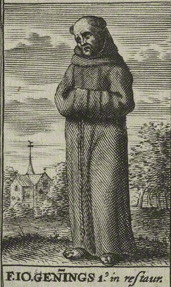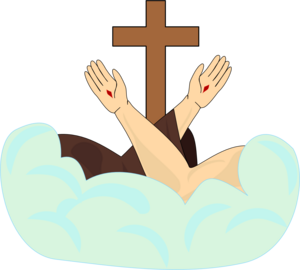John Gennings facts for kids
Quick facts for kids
John Gennings
|
|
|---|---|
 |
|
John Gennings (born around 1570 – died November 12, 1660) was an Englishman. He became a Catholic because his older brother, Saint Edmund Gennings, was killed for his faith during the English Reformation. John Gennings later helped bring back the group of Franciscan friars in England. Sometimes his name is spelled Jennings.
Contents
Edmund Gennings: A Brother's Sacrifice
Edmund Gennings became a Catholic when he was about 16 years old. Soon after, he went to Rheims to study and become a priest. When he returned to England, he met his younger brother, John, near Ludgate Hill. Edmund spoke to John without telling him who he really was. He just said he was a relative. Edmund asked John what had happened to his brother Edmund.
John told him that he had heard Edmund "had gone to Rome to the Pope." He also said Edmund had become "a notable Papist and a traitor both to God and his country." John believed that if Edmund came back, he would "be hanged infallibly" (meaning he would definitely be executed).
Edmund didn't think it was the right time to try and convert his brother. So, he just told John who he was, but didn't mention he was a priest. The brothers soon went their separate ways. Edmund continued his short time as a priest until he was arrested on November 7, 1591. This happened after he led a Mass (a Catholic church service) at the home of Swithun Wells in Gray's Inn. Edmund was executed on December 10, right outside that house.
John Gennings: His Own Path to Faith
John Gennings later wrote a book about his brother's life. In this book, he shared how his brother's death led him to become a Catholic.
After joining the Catholic Church, John went to Douai College. He became a priest in 1607. The next year, he was sent on a mission to England. There, he started wishing to bring back the English group of Franciscans. Franciscans are a type of friar, which is a member of a religious order.
John found Father William Staney, who was in charge of the English friars. From him, John received the "religious habit" (meaning he officially became a Franciscan). This happened either in 1610 or 1614. After this, John went to a convent (a religious house) of the Franciscan order in Ypres, Flanders. Several English friends joined him there. One of them was Christopher Davenport, who was known as Franciscus a Sancta Clara. He later became famous for arguing about religious topics.
This was how the new English Franciscan group began. Father William Staney saw how dedicated John Gennings was. So, he gave John the "seal" of the old English Franciscan group. This seal was like an official stamp or symbol.
Bringing Back the English Franciscans
Next, John Gennings worked to get a house for the English friars in Gravelines. But in 1618, he got permission to set up a place in Douai instead. Many of the friars who had joined John had studied at Douai College. By moving to Douai, he hoped to always have new people joining the group.
The job of bringing back the English Franciscans was officially given to John by the main meeting of the order in 1618. He was named "Vicar of England," which meant he was in charge. To help him, the head of the Belgian Franciscans was allowed to gather all English and Scottish friars from anywhere in the order. Another decision from the same meeting placed the English Poor Clares (a group of nuns) in Gravelines under the care of the English friars.
Becoming a Custos
By 1625, the number of English friars had grown a lot. John Gennings sent Father Franciscus a Sancta Clara to Rome. His job was to ask for the English group to be officially recognized under Catholic Church law. The request was approved. The only rule was that the leader of the group could not be called "provincial." Instead, he would be called "custos."
New Convents Established
In 1629, this rule was removed. Friar John Gennings was then named the "minister provincial," which is the main leader. The first official meeting of the new group was held in Brussels in Advent (around December) of that same year. It took place at the convent of the English sisters of the third order. John Gennings himself had started this community of sisters in 1619. This group of sisters was set up in Taunton, England, with another house in Woodchester.
Father John Gennings was chosen as provincial again in 1634 and once more in 1643. John Gennings passed away in Douai on November 12, 1660.
Sources
- Richard Challoner: Memoirs of Missionary Priests
- Encyclopædia Britannica, 15th Edition
 This article incorporates text from a publication now in the public domain: "article name needed". Catholic Encyclopedia. (1913). New York: Robert Appleton.
This article incorporates text from a publication now in the public domain: "article name needed". Catholic Encyclopedia. (1913). New York: Robert Appleton.


